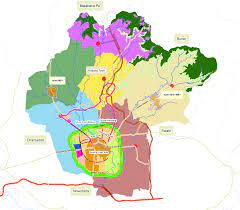Land disputes are one of the contested issues inherited the tribal districts, but after the merger, it has been constantly erupting into violence due to the government’s inactiveness. These disputes could be broadly categorized as 1) between individuals, 2) between tribes, 3) and government and the locals. Meanwhile, the lack of government interest in establishing a land record is not only the reason behind the violence, but an impediment to the progress of the tribal society.
The former FATA has an area of 27,220 sqkm with a population of over five million, but there is no official land record publicly available. Keeping in view the need for the land records the FATA reform committee had one of the recommendations of establishing a Geographic Information System (GIS) based online land records available and easily accessible to all. After the formal merger of FATA into Khyber Pakhtunkhwa (since May 2018) the process of land record has not been initiated in the merged districts, except a pilot project successfully carried out in the Alamsher and Dingeela villages of Kurram district and the land record is made available online.
A proper revenue department has not been established in more than three years. In 2019 the land-laws were extended to the merged districts, empowering the deputy commissioner and additional district commissioner, political tehsildars were entrusted to collect the revenues. The KP revenue department outlined a project for land distribution in 2020 (available on their official website) but so far, practical steps are missing.
Another land-related issue is illegally acquiring local land by the government institutions which eventually results in conflict/dispute between the government and locals, erupting into violence (for instance; National Logistics Cell claims on locals’ land at Torkham and Angoor Ada border). Though there is no visible formal record, locals verbally (informally) recognize the ownership of land, yet still, claims over each other’s land rise and turn into conflict causing human losses (like the Karkanra dispute in South Waziristan, Sherjan Kallay and Sago Kallay in Kurram clashes over shamilat). The multi-reasoned various nature disputes can be resolved amicably through local engagement and participation but require the commitment of the government.
The land record and distribution of land (referred to as land reforms) is essential for social and economic growth, satisfying human rights, and promoting peace in the merged districts. We cannot hope for progress and better life without land distribution and formal documentation.
Land reforms in the first-place secure individuals’ ownership rights of the land. Most of the land is owned by families and tribes and individual ownership is limited. Secondly, individuals would be able to sell/purchase land or start business activities such as market, hotel, industry, cultivate crops, cattle farming, to add in Agri-production. This could be helpful to boost economic activities in the region and hence economic prosperity in the long run.
Land reforms in the first-place secure individuals’ ownership rights of the land. Most of the land is owned by families and tribes and individual ownership is limited. Secondly, individuals would be able to sell/purchase land or start business activities such as market, hotel, industry, cultivate crops, cattle farming, to add in Agri-production.
The social impact could be enormous as it would bring an end to the existing social rifts amid land issues. The justified distribution of land can end inter-families or intra-tribe disputes over land. In the Waziristan district, it has been observed that a segment of tribal society in the post-military operation phase did not return to their areas. Their houses are destroyed during the conflict and since then the family size has increased so it requires a larger area to rebuild. So, the land distribution will allow the displaced families to construct homes on their ancestral land. It is now the responsibility of the tribal elders and government to initiate the land distribution process and distribute it among individuals to make possible the return of the fellow tribesmen. The returning of the locals will re-establish social cohesion and will enhance social relations that have been weakened over decades of displacement. Social services such as education and health facilities will be established by private entities to foster competition and improve access to social services along with government institutions.
Land ownership rights are guaranteed by the constitution of Pakistan and international laws. Land reforms will enable individuals to secure the right to own property. The women in the merged districts in the present pattern of land are in a disadvantageous position and cannot claim their right to land or cannot own or inherit property. To facilitate the female folk of the society the land distribution and establishing a land record is necessary. The courts (established after the merger) cannot protect individual rights to land ownership due to the absence of a revenue department and documents of the land. The land disputes cannot be brought into the courts as the court requires documentary proof that is not available to the individuals.
The exact number of individuals killed over land disputes is unknown, but every village or tribe and even every family has land disputes and some of them erupted into violent conflict. Land reform will reduce the cases of violence in the merged districts which remain volatile over decades. The government role in such conflict is questioned as it failed to intervene and resolve the dispute.
The government’s unwillingness to establish land records or provide the available documents to allow the resolution of land-based conflict is very disappointing. The available document with the government should be handed over to the elders who are involved in dispute resolution. To stop the violent disputes, the police, local administration, and the elders are needed to play their roles actively.
To ensure land records the revenue department system should be properly extended to all merged districts where it can start work on land documentation and establishing of GIS-based land records. The social and political leadership of the respected districts should be engaged to smoothly run the process instead of adopting a bureaucratic and colonial approach as observed in the Mines and Mineral Act, which, unfortunately, deprived the locals of the resources in the land they owned for centuries. A public centric approach should be adopted instead of a state-centric approach where decisions come from above without local participation. To ensure smooth distribution of land, the British era available land records could be consulted. The British era records would help resolve land-based conflicts which is the demand of the parties in the dispute over Karkanra (located in the Wana subdivision). The tribal wisdom and distribution practices could further facilitate land reforms. Keeping in view the prospects of land reforms priority actions are required from the government and the tribal political and traditional elders.























